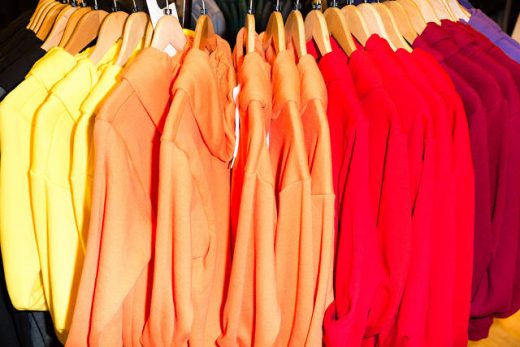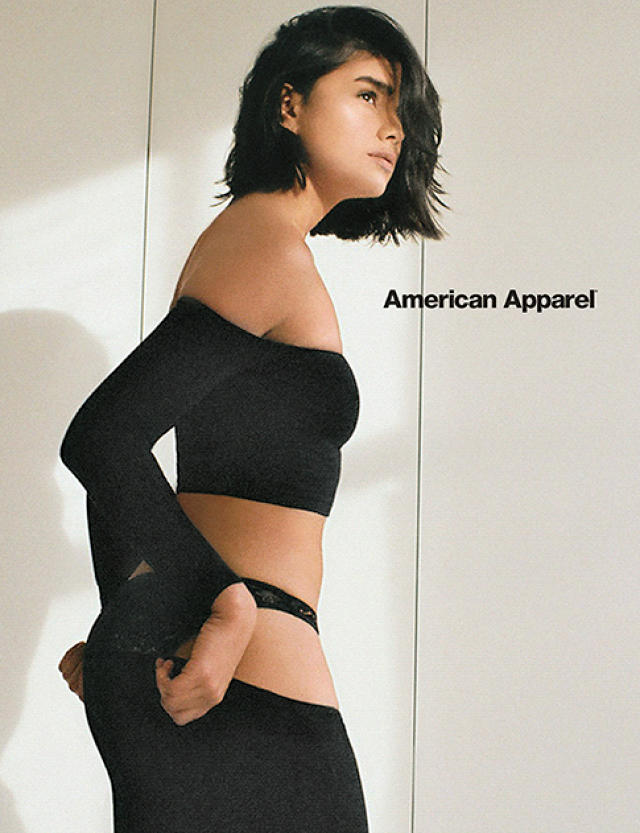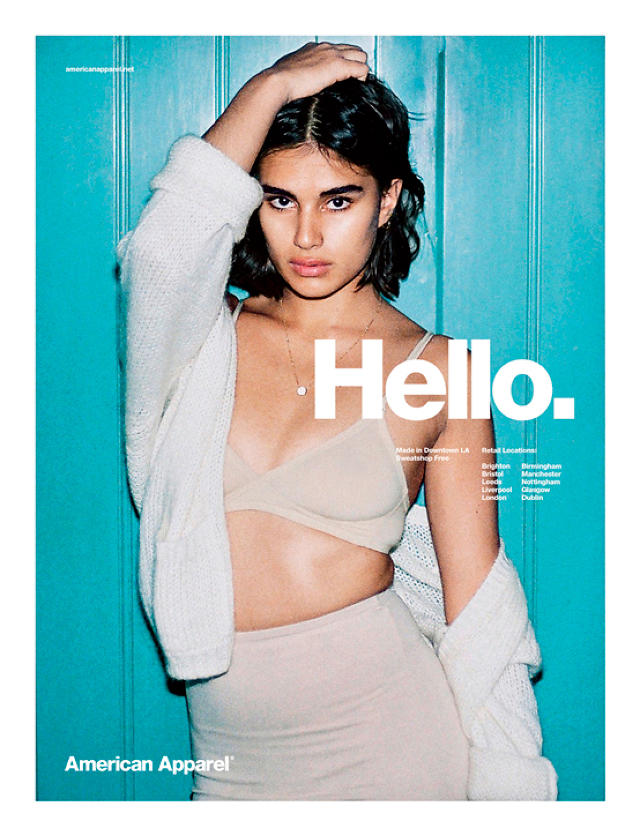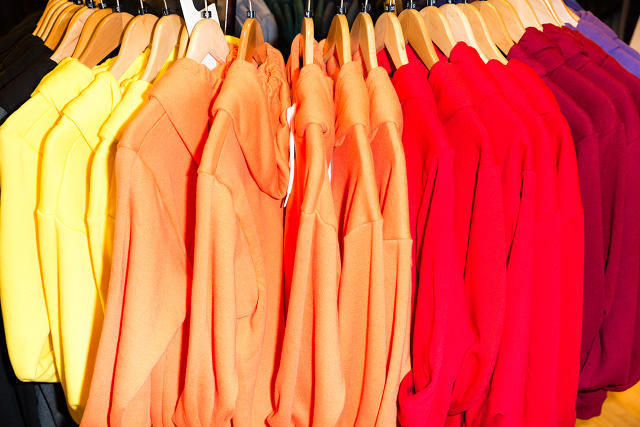Can American Apparel’s CEO Mend Its Seams?
Everything seems normal as we approach American Apparel’s seven-story factory and corporate headquarters in downtown Los Angeles. I’m riding shotgun next to CEO Paula Schneider in her slightly worn electric Ford Fusion, ’80s music jamming quietly from the speakers. We park and enter the light and orderly American Apparel shop on the ground floor. As Schneider shows off some recent display changes, I notice that we’re the only ones in the store but don’t think much of it—it’s still only about 10:30 a.m. on a Friday, and the building isn’t located on a high-traffic street.
But as we head toward the building’s corporate entrance, I realize something’s a little weird. I see gargantuan, tattooed men in blue shirts smile attentively near the doorway and I vaguely recognize one of them, which is implausible—I don’t live in L.A. It takes me a moment to realize that I saw his face earlier in the day, when I had met Schneider for breakfast in Little Tokyo. When we had gotten in her car afterward, she seemed to be waiting for the car behind us to pass (it didn’t), so I had looked through the rear window to find out what was going on. Now I realize that this man had been following us all along. The security guards accompany us on the ride up the elevator, past six factory levels to the top floor of the building, where another guard greets us and uses his key card to let us through to the company’s offices. The percussive hum of textile machinery below fades as the heavy door closes behind us.

It’s not unheard of for famous CEOs to employ private security, but Schneider isn’t Jack Dorsey or Mark Zuckerberg—she’s running what is essentially “a T-shirt business,” as she puts it. However, this is no ordinary T-shirt business. Not only is American Apparel one of the most controversial clothing manufacturers of the 21st century, dealing with retail woes similar to those faced by brands like Gap, Uniqlo, and even J.Crew, but it is recovering from such a tumultuous and dramatic series of years—including sexual-harassment allegations, layoffs, bankruptcy, and protests—that Hollywood stars such as Adrian Grenier reportedly want to option the movie rights. Schneider, the target of heated demonstrations since she became American Apparel’s CEO, is attempting to steer the company toward a bright and less complicated future, motivated by the 7,500 employees depending on her to preserve their jobs, as well as the bondholders who took over the company in a debt-equity swap during its bankruptcy restructuring last year. And if it takes a security detail to enable her to focus on this, so be it.
When I meet with her, 16 months into the job, she knows what she is up against. After all, Schneider had told me over breakfast, “one year is like 17 years at American Apparel. And this has been a very wild year.”
American Apparel launched in 1988 as a T-shirt business that founder and former CEO Dov Charney ran out of his dorm room at Tufts University. After Charney opened his first retail store, on Los Angeles’s Sunset Boulevard in 2003, the brand quickly became a phenomenon, famous for its local, sweatshop-free manufacturing and notorious for its sexually charged advertising. Much of the artsy, indie subculture that emerged in the early 2000s dressed the way it did in part because of Charney’s knack for producing high-quality, affordable basics, and kitschy, often provocative items such as thong bodysuits, shiny disco pants, and striped knee socks. As it became a public company in 2007 (through a reverse merger), American Apparel had 143 stores in 11 countries and was valued at nearly a billion dollars.
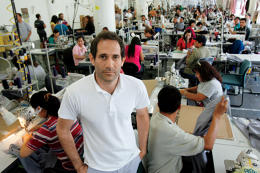
It wasn’t just the merchandise that set the company apart. From the beginning, American Apparel eschewed fast fashion (the practice of copying new runway trends immediately and cheaply) in favor of generating its own iconoclastic staples. Instead of outsourcing manufacturing to low-wage overseas workers, it produced almost everything it sold for wholesale and retail in its own factory in Los Angeles, by employees working above minimum wage with access to on-site services like English classes, massages, yoga, and a medical clinic.
It also didn’t Photoshop the models in its ads—and many were not models at all, but company employees. “American Apparel turned advertising upside down,” says the company’s current SVP of marketing, Cynthia Erland, who came aboard last year after Schneider took over as CEO. “It was brilliant what they did to bring in real girls, unretouched, and now you see it everywhere.”
Many of these young women were featured, snapshot-style, in casually lascivious poses, taking fashion’s penchant for sexualized imagery to a new level: exposed nipples, spread legs, and visible pubic hair all made appearances in the brand’s advertisements over the years. (Occasionally, porn stars were used as models.) A number of these ads were shot by Charney himself, sometimes in his own bed. Once in a while, he’d appear in the ads.
-
Print ads from 2004 to 2006
-
Print ads from 2004 to 2006
-
Print ads from 2015 and 2016, created under Schneider’s leadership.
-
Print ads from 2015 and 2016, created under Schneider’s leadership.
The strategy seemed to work, and sales continued to grow, but watchdogs howled. It didn’t help that Charney was being hit with multiple allegations that he had sexually harassed female employees. (Charney did not comment on the record for this story.) Several lawsuits would be filed against him, all eventually dropped or settled in private arbitration. By any measure, Charney was an unconventional manager, dating employees and occasionally wearing American Apparel underwear at the company’s headquarters.
The company took risks with its balance sheet as well. In the wake of global expansion (119 new stores between 2005 and 2008), it took out a series of high-interest loans—but as sales slowed after the recession, the expansion failed to throw off enough cash flow to service the debt. Along the way, even when sales picked up, the company was buffeted by operating snafus like a $15 million overhaul at a new distribution center.
In the spring of 2014, deciding that American Apparel would need a change in leadership but knowing that Charney wasn’t going to leave quietly, the board hired a private investigator to look into Charney’s activities, allegedly uncovering years’ worth of salacious emails and texts, as well as videos and photos of Charney and other employees naked or engaged in sexual behavior at work. A video of Charney dancing naked was leaked online, sparking a media flurry.
That July, the board suspended Charney as CEO, citing the old harassment suits and financial mismanagement as justification (a few months earlier, American Apparel had stated in a prospectus that it would be “particularly harmful” should Charney exit the company). With an interim CEO in place, Charney remained at the company as a paid consultant. He made a deal with a hedge fund, Standard General, that he hoped would help him regain control of the company (ultimately, the deal did not work in his favor). He also hoped that the board would bring him back if he found the right partner. He turned to his friend Ilse Metchek, the president of the California Fashion Association, for help. “I’m kind of a mother figure to him,” she says with a laugh. “He is nuts, but I love him.” She connected Charney with Schneider, another longtime friend, who had 30 years of experience at apparel companies like BCBG, Laundry by Shelli Segal, and Warnaco, and most recently was a senior adviser to a private equity fund identifying turnaround opportunities in the sector.
Metchek suggested Schneider, a process-oriented mother of two with a calm, confident, direct demeanor, for her operational experience. “At that point, Charney and the board acknowledged that operationally somebody was needed,” Metchek says, “and he was confident that he was remaining on as the chief merchant.”
Charney and Schneider met in the fall of 2014. Schneider recalls that they “had a good conversation,” but that he was always being offered just a consulting position. “It was to work together, but not as co-CEOs,” she says.
The board announced in December 2014 that Schneider would be the sole CEO—and that Charney was officially being terminated. Charney responded by filing multiple lawsuits against the company; the accusations ranged from conspiracy to defamation. On January 5, in spite of the financial struggles, Schneider took the helm. American Apparel “is an incredible brand,” she says. “Who wouldn’t want to be involved with a brand this strong?”
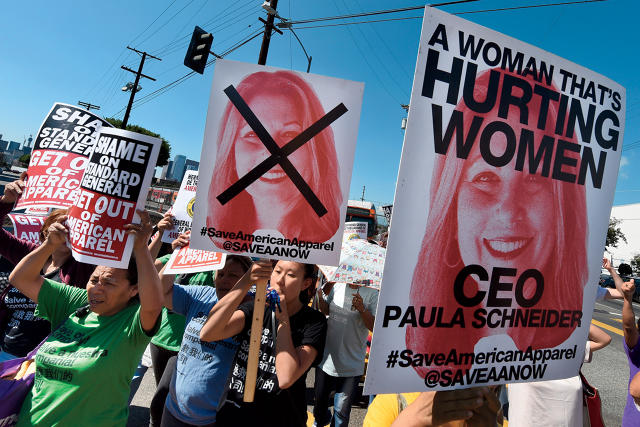
Nothing could have prepared Schneider for what happened next. First, the company didn’t have enough liquidity to produce its full spring lines for 2015. She was forced to institute production-floor measures that cut overtime for factory workers (before she arrived, Schneider says, the company was spending $10 million to $15 million annually on overtime pay). She eventually closed 40 underperforming stores. And there were layoffs. “We had to save money, and we started furloughing people, and that is what opened the door for a lot of unrest,” she says. “And I can understand that. But I had no choice, or we were going to go to a very bad place very quickly. Otherwise, everybody would have lost their jobs.” The logic behind the decision didn’t make it any easier: “It’s still a miserable experience,” she says. “To watch these people have to walk out the door is painful.”
The “unrest” began as protesting—and escalated from there. Laid-off and remaining factory workers linked up with labor activists and began demonstrating against Schneider and the board. They also began efforts to unionize workers (American Apparel has discouraged unionization efforts inside the company). Creative executives loyal to Charney who had quit or been fired joined the crowds in the factory parking lot giving speeches, waving signs, and handing out flyers decrying Schneider and the board. Sometimes there were hundreds of protesters. Sometimes Charney himself appeared. (In June 2015, the board obtained a restraining order against Charney so that he could not say negative things about the company or actively try to get board members removed.)
Schneider witnessed this dissent through the windows of her mid-century-style office. “There have been moments, like when I first saw my face on a [protest] placard and went, ‘Oh, my God,’ ” she recalls. “It was a bit appalling, and then you’re like, Okay, that’s how we’re gonna roll. I have skin like an alligator at this point. I have to.”
VP of marketing operations Sabina Weber, whom Schneider recruited from Universal Music, recalls that “there were demonstrations at 1 o’clock every Wednesday. We knew to shut the blinds, shut the windows, turn the music on, lock the doors, in case they could come upstairs and bust them down—which did happen once,” she adds, referring to an incident when protesters made it past security and attempted to access the company’s offices. “We were standing behind and pushing the door closed. [There were people] in tears,” she claims.
After the episode, Schneider installed more guards at the building. The company’s offices were moved from the fifth floor, where creatives had sat alongside sewers and cutters, to the seventh floor—a move that some factory workers, especially the Charney loyalists, considered symbolic of a chasm between senior management and blue-collar employees. Clashes persisted (Chief Digital Office Thoryn Stephens recalls meeting with Schneider in her office when a newly fired member of the creative department burst in, screaming at her before security arrived), as did mistrust. “We couldn’t leave any documents lying around because they would get taken and shared and posted online,” Weber says. Internal financial statements were leaked to BuzzFeed, for example, by disgruntled employees whom Weber says have since been “purged” from the company. “The people we have now, we trust,” Weber says.
The ongoing drama took an emotional toll. “It was really crazy,” says co-branding director Jonny Szymanski, who worked for both the old and new regimes. “Thank God our insurance was always good here, so I had a therapist,” recalls Szymanski, who lost friends during the leadership transition. And some employees ultimately decided working for American Apparel wasn’t worth the stress. “I lost employees,” Stephens says. “It takes a certain kind of individual to still be here and thrive in this environment.”
The internal turmoil and financial trouble forced Schneider to be resourceful—and forceful. “We were always struggling for cash right after we took over the company,” former board chair Colleen Brown recalls. “One of the first things [Schneider] did was ask the question, ‘What can we use to make into garments, what do we have on hand, raw materials, that’s in our inventory?’ And the answer to that was basically, ‘We don’t have anything that’s of worth to use.’ But she basically got up herself and walked down to every place [in the factory] where fabric might be stored, identified yards and yards of fabric, and said, ‘What about these?’ I said, ‘Oh, well, yeah, we own those but the designers don’t want to use those,’ and she’s like ‘Aaaand, why not? It’s good enough to cut it.'”
“She had some of our best-sellers that she made out of what was originally discarded fabric,” Brown remembers, “and not because it was flawed fabric, but because it wasn’t to [the designers’] taste.” Some items created from that leftover fabric—including a flowered jumpsuit—sold out, Brown says.
But with a $311 million debt load—interest payments alone were more than $35 million a year—and share prices about to hit bottom at 11 cents (down from a high of $15.80 in 2007), that kind of resourcefulness was not going to be enough to save the company. Schneider and the board concluded that the only way forward was through bankruptcy. In an August 17 regulatory filing, they publicly affirmed their doubts about having enough liquidity to get through the next 12 months. Two days later, factory workers and activists, protesting lost wages, used a multicolored stick to beat up a 6-foot-tall piñata of Schneider in the factory parking lot. The piñata version of Schneider clutched a bright orange Birkin bag painted with a dollar sign. “I do have an orange bag,” Schneider says, finding some humor in the situation now (she says it’s not a Birkin). She watched the activity through her office window, then closed the blinds and got back to work.
American Apparel filed for Chapter 11 bankruptcy on October 5. A consortium of creditors (including Standard General, Monarch Capital, and Goldman Sachs) agreed to convert $200 million in bonds into equity and provide $90 million in financing, plus $70 million to help address liquidity problems. The plan would wipe out the remaining investments of Charney and other former employees, along with all other shareholders. The New York Stock Exchange began delisting American Apparel later that month.
Charney countered in January with a $300 million takeover plan of his own, backed by two creditors—Hagan Capital Group and Silver Creek Capital Partners. American Apparel rejected the offer, and Charney’s hopes were dashed when Schneider’s restructuring model was approved by the bankruptcy-court judge. American Apparel emerged from bankruptcy as a private company at the end of the month, sparking a new round of protests.
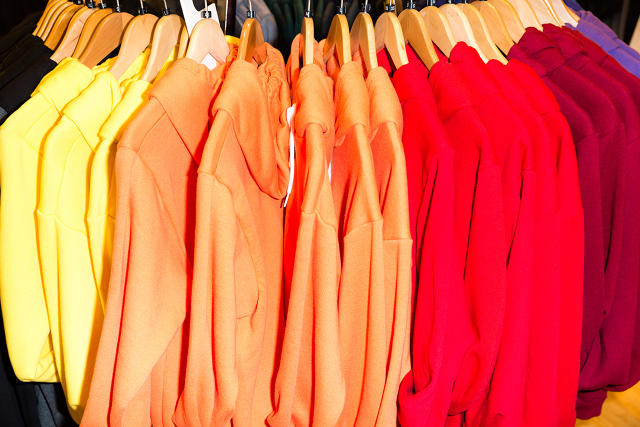
A few months later, things have cooled significantly. The protests, though not entirely over, have decreased (“It’s not every Wednesday at 1 o’clock,” Weber says), and the crowds have gotten smaller. Charney has turned his attention to building a new basics company in Los Angeles; former American Apparel workers are part of his effort.
On American Apparel’s sewing-room floor one April afternoon, workers—many from Central America and Southeast Asia—guide swaths of colored fabric beneath the buzzing needles. Some wear masks to protect themselves from tiny particles of cloth, which float visibly in soft rectangles of light near the windows. Latin music begins to play over the loudspeakers, and everyone stands up to stretch, a mandated break led by pairs of women in the middle of the room. Everyone looks tired, but some joke and laugh with each other as they go through their routine, lifting their legs and rotating their wrists. It’s a particularly bad week for the workers, as nearly 500 of their colleagues were let go a few days earlier in another round of layoffs, but still a few women bust out a couple dance moves.
Now that the company has emerged from bankruptcy, relieved of immobilizing debt and free from Wall Street expectations and public-disclosure pressures, Schneider and her team are focusing on the fundamentals, instituting more organizational processes inside the company and improving its wares. “You can have a lot of brand value, which this company has, but we need to bring it back to the product,” Weber says. “The brand has been running on fumes for a long time.”
Production and design now follow a strict calendar, set by Schneider. “You have to have your raw materials where they’re supposed to be, your bundling down, your product cut up and ready to sew—there are a thousand steps that go into making this run smoothly,” Schneider says. “And it’s more complicated [at American Apparel] because you’re knitting your own yarn, you’re dyeing your own fabric, and you’re manufacturing everything here and shipping everything yourself.” In part, as a result, niche items that fall outside of American Apparel’s knit-production expertise—sweaters, denim—are now being outsourced to other factories around Los Angeles.
This outsourcing has been a hot topic within and outside the company—after all, MADE IN DOWNTOWN LOS ANGELES has been a central part of its branding for years. Workers (and labor activists) worry that outsourcing beyond American Apparel’s own factory is just a step toward moving production outside of the United States. But, “no one’s good at everything,” says James Yunker, American Apparel’s head of product and design, who worked under Charney for four years. “Reaching out to other companies within America that specialize in certain items allows us to bring down our costs.”
Metchek agrees. Schneider “is making some very smart moves in terms of outsourcing the manufacturing merchandise that they are not proficient in,” she says.
Schneider insists that the company will continue to manufacture in America, even if specialty items are created in other factories. “It still means American jobs, whether [people] are hired directly through the company or they’re working for another company and [making products] for us,” she says. One thing she learned during a brand audit she commissioned last year is that outsourcing to another country would be damaging in the long-term, despite any near-term financial benefits. “American Apparel can’t afford to not be American. People care a lot about ‘Made in America,’ which is great,” she says. “It’s not called Chinese Apparel, it’s American Apparel.”

The whitewashed walls on the company’s 7th floor are decorated with typical American Apparel advertisements—young women’s bodies draped in provocative poses, a topless girl covering her breasts with a casually placed arm. A young man exits the company’s “gender neutral restroom” as I walk down the hallway. People at the desks I pass seem relaxed, like they might even be having fun.
In almost every way imaginable, Schneider’s management style differs from that of her predecessor. There are certainly some employees who still don’t entirely trust her yet, but it’s also easy to find current staff who appreciate the way their new CEO has led the company during its troubles. Schneider is what marketing chief Erland calls a “macromanager,” letting other people run their own departments. “She’s not a micromanager,” agrees co-branding director Szymanski, adding that roles are more organized and focused now. “I feel like before, everybody did like five or 10 different jobs and it was hard to keep focused,” he says. “Now I’m learning so much that will be valuable for my next career move.”
“If someone comes to me and says, ‘Everything is screwed up,’ then I make them list everything,” Schneider says. “And then after once or twice, no one does it again, because no one wants to list everything. Here, it’s about finding solutions.”
Schneider, employees say, trusts her team to be more expert than her in their specific fields. “She does have good design sensibility,” says head of women’s design Remi Costeplane, who arrived at American Apparel from Juicy Couture earlier this year (along with head of men’s design Joseph Pickman, a Band of Outsiders alum who joined American Apparel last year). “But she doesn’t pretend to be a designer.”
That doesn’t mean Schneider is disconnected from what’s happening inside the company, says merchandising director Tasi Rippell, who also worked at American Apparel in the late 2000s. “I speak to her two or three times a week about product, ” Rippell says. “Every single week I wheel in everything that’s hitting the stores,” she says, which is when she and Schneider discuss how all the company’s processes are positively or negatively affecting what’s making it into the retail locations, examining every step all the way back to the production process.

Schneider didn’t start off thinking she’d be so focused on the logistics of wholesale and retail—growing up in the Bay Area, she enjoyed making jewelry and stained glass and spent her summers working at Renaissance Fairs in costumes she made herself. She enrolled in Chico State University (attracted to its status as the number one party school in the nation), where she created a new major for herself: costume design. She’s held a number of roles in the clothing industry, though never as a designer—and, as she says, some of her exits from those jobs “have been more mutual” than others.
But nothing that has happened to her on the job compares to what she went through after she was diagnosed with an aggressive form of breast cancer in 2007, while she was working at Warnaco. Schneider, now 58, endured two years of chemotherapy, radiation, and a double mastectomy as a result. “It wasn’t easy, and I’m tough,” she says. “It’s probably why I can do this,” she says, gesturing at her office. Hanging on the wall is an orange painting gifted to her by her husband. It depicts a burning castle. Off to the side, a warrior holding a spear is running toward the flames. “My husband gave me this painting because he said it reminded him of me. I’m the warrior and that,” Schneider says, pointing to the fiery castle, “that’s American Apparel.
Under Schneider’s leadership a slew of new initiatives, large and small, are coursing through the company. Product chief Yunker is engaged in a subtle revamp of American Apparel’s clothing, refining fits and upgrading materials—like a more modern, lighter-weight fabric for its women’s T-shirts. “[Dov] did an amazing job of building the brand,” says head of women’s design Costeplane. The goal isn’t to dramatically overhaul the company’s offerings, Costeplane says, but to “keep them up-to-date.” A recent store redesign has been implemented to help customers better find those updated products, a partnership with Postmates has sped up delivery times for online purchases, and Stephens’ team is focusing more on data—such as which items customers are looking at most on the website or which items they are trying on the most in fitting rooms (thanks to RFID tag technology first instituted during the Charney era). The company has also ramped up its Snapchat and Instagram promotion, aiming to attract customers who weren’t even born when Charney sold his first ringer tee.
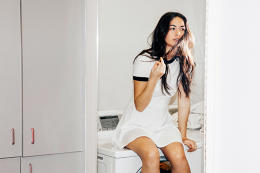
Meanwhile, Schneider’s marketing team is attempting to tone down American Apparel’s ads without diluting the brand. “All we did is change the gaze from a voyeuristic male gaze to [a] female point of view,” Schneider says. “She should still be sexy, or he should still be hot, but it’s not as sexualized.” Design director of branding Benno Russell (who worked for the company for 11 years until he left in 2014, and was rehired by Schneider’s regime last year) says the distinction between the two points of view is pretty simple. “The male gaze entails that you’re creating an image for male consumption—and if you refute that, the opposite is the female gaze,” he laughs. “It’s crucial you have somebody being photographed who feels empowered and is empowered, versus someone who is more subjugated,” he adds.
Gone are the spread thighs and bare breasts, the nipples visible through sheer clothing—to the dismay of many former employees and American Apparel die-hards, who fear that the brand is in danger of turning into Gap. “One thing that came back from the brand audit,” Erland responds, is that for many American Apparel customers, “the overly sexualized is offensive.” And even Russell believes that some of the explicit imagery of previous campaigns “was unnecessary.” Now, he says, “we definitely want to, in a poetic move, hand the camera to a woman or somebody who is in touch with more of their feminine sensibilities.”
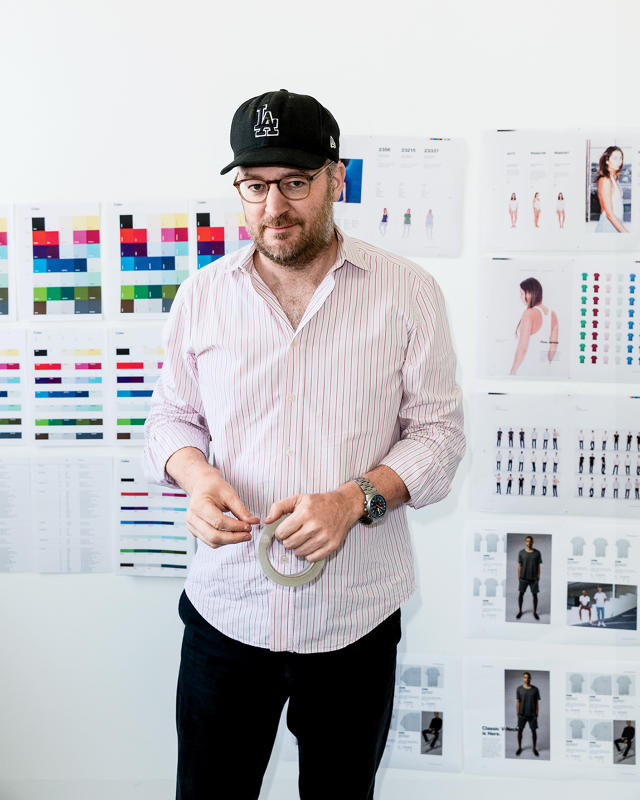
Schneider is also trying to lean on the progressive community that has long existed around the brand. Known for its “Legalize L.A.” immigration campaign and its “Legalize Gay” marriage efforts, American Apparel is adding feminist and voter-mobilization efforts. In June, it debuted a line of “Make America Gay Again” hats and clothing, a direct shot at Donald Trump. Tapping into maker culture, Schneider is positioning American Apparel’s website and stores as a platform for outside artisans and designers to submit accessories and housewares for inclusion in American Apparel stores. It’s planning small-batch testing of these items at retail locations in late summer.

“This will take two to three years,” Schneider says of the company’s comeback plan. But she still faces liquidity issues; only about 20% of American Apparel’s spring 2016 product line was available in retail locations. The company literally didn’t have enough money to produce it all. It will also be continuing to off-load excessive inventory from previous seasons—product that “still generates income, but has stayed at the party too long,” Schneider says. “This is like somebody who has gained a thousand pounds, and then in six weeks expecting them to lose it.”
Unlike other retail chains, which outsource their manufacturing and can quickly copy new runway blockbusters, American Apparel isn’t constructed to pump out an endless range of products; it can’t cast a big net like Zara or H&M and hope for some hits. So it is taking the opposite approach, trimming and refining its offerings. “If you’re in fast fashion, you have to replace,” Schneider says. “If you’re American Apparel, you have to evolve.” All of this takes patience, and money, something the company still doesn’t have enough of. “We just barely eked along, [my] first year,” she admits.
Many of the people I talk to at the company are confident that the turnaround will work. “Why else would I be here, if I didn’t believe that?” Yunker says. Others aren’t entirely sure. “Ask me again in six months,” Weber says dryly.
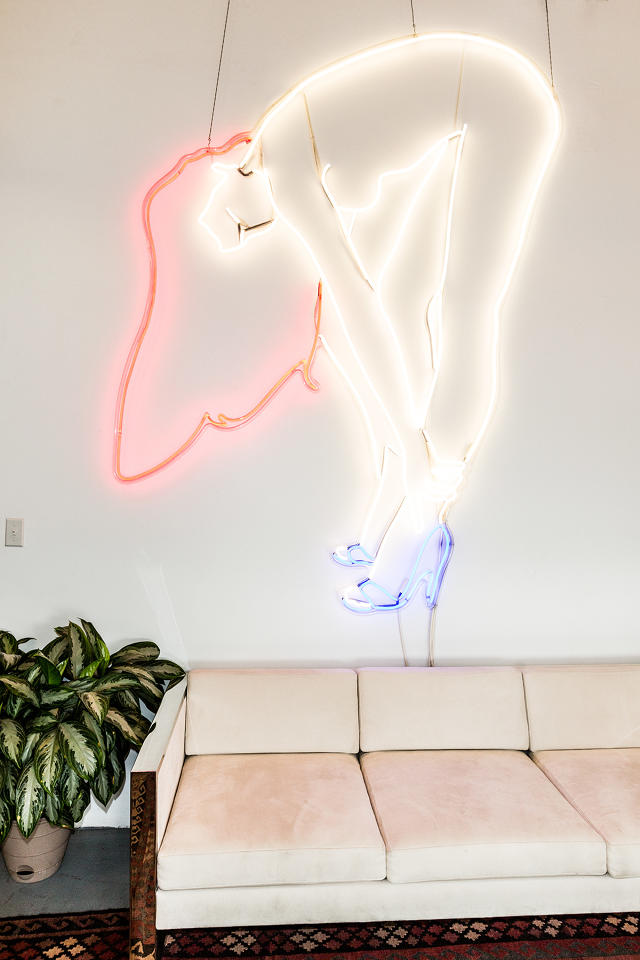
As for Schneider, “I’m invested emotionally,” she says passionately. “I feel inspired by the good that American Apparel can do. It has a social conscience—it leans left, I lean left. It has a big voice that I think can be helpful to a lot of people. It employs a lot of people.” Even so, there have been moments when her family pressured her to resign. “Sometimes my kids have said, ‘Mom, is this worth it?’ When they looked at the piñata video they were like, ‘Oh, no, oh, no.’ ”
I ask her about this as we get back into her car on our way to dinner at Perch, one of her favorite restaurants in Los Angeles. She struggles with her seat belt, then gives up. (It’s broken, she tells me, insisting that her other car is nicer.) Then she laughs a little, recalling her grueling battle with breast cancer. “When you’re sick and you get better, I think you look at things a little bit differently,” she says. “You don’t sweat the small stuff.”
Watching people kill your piñata effigy isn’t exactly small stuff, I suggest. She shrugs. “It wasn’t going to stop me,” she says, pulling out of the parking lot, her bodyguard trailing us in his car. “Those were scare tactics. I have a business to run.”
[Photos: The Collaborationist: Jessica Haye & Clark Hsiao; Ads: leotard, Japanese print ad, 2006; “Meet Melissa” print ad, 2005; black top, underwear and skirt print ad, 2016; “Hello.” print ad, 2015)]
A version of this article appeared in the September issue of Fast Company magazine.
“I’m invested emotionally,” says CEO Paula Schneider of the company’s turnaround effort. “I feel inspired by the good that American Apparel can do.”
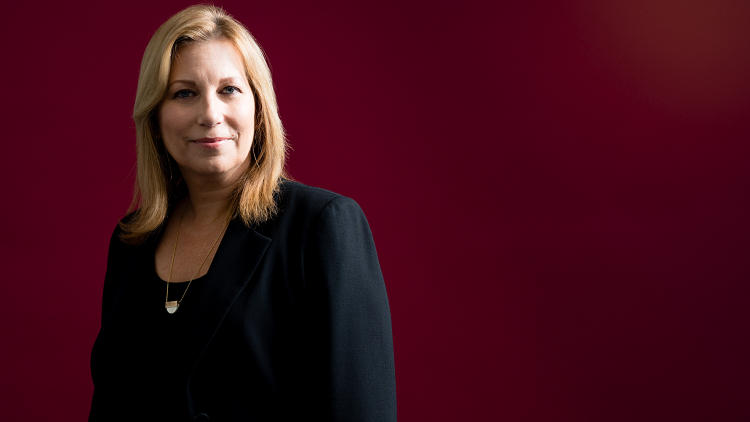
Director of engineering Gustavo Alvarado joined American Apparel earlier this year to help lead and streamline manufacturing processes in the factory.
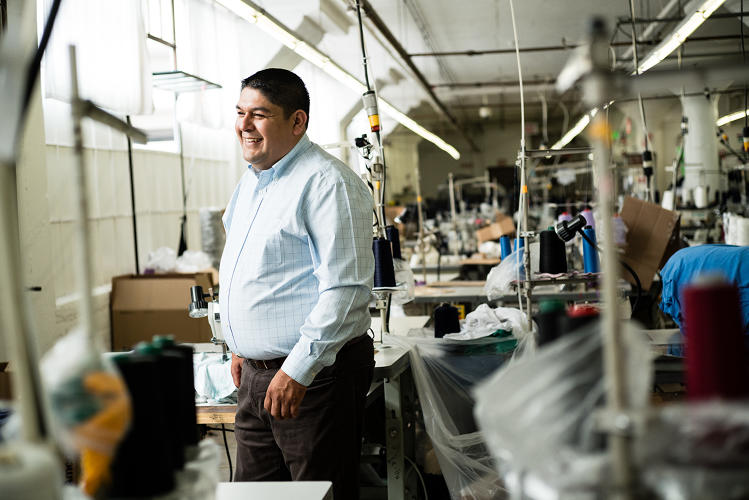
Director of costing Margarita Najera is charged with making the factory more efficient and productive for both the company and workers.
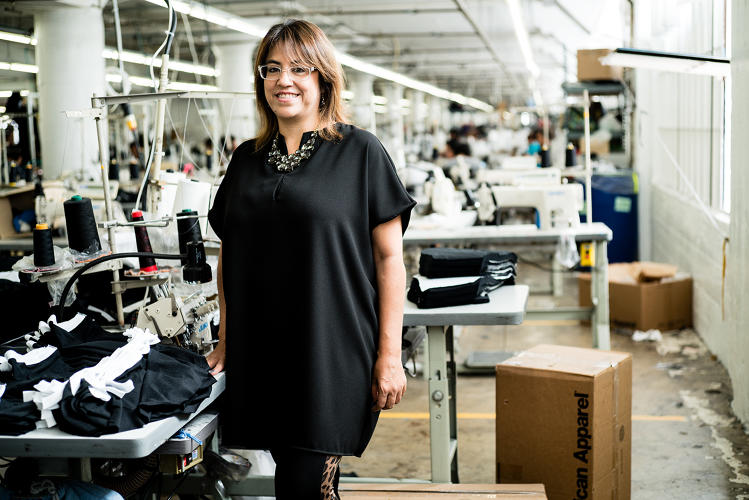
Factory workers have endured layoffs as the company seeks to create a sustainable future for itself.
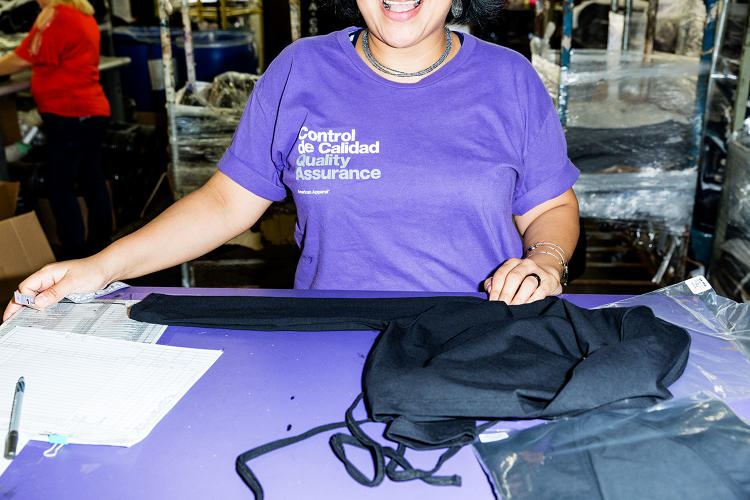
A cutout image decorates a wall of the photo studio at American Apparel headquarters in Los Angeles.
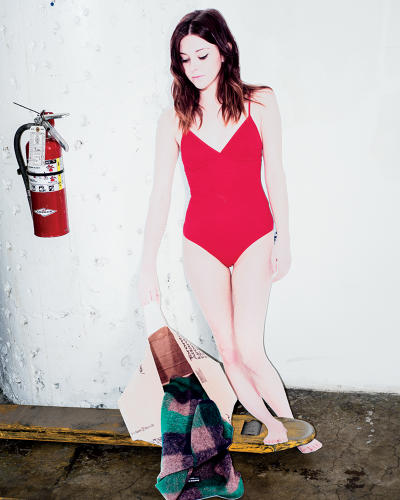
Fast Company , Read Full Story
(84)

